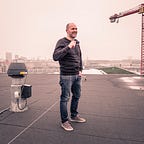Service as a Software
In a recent interview with TechCrunch, Jessica Ma (founder of American startup inDinero) used the words “service as a software” to explain what her company does. While the interviewer dismissed it with a quick “I’m not sure that’s going to catch on”, I am of the idea that there is more to it than just a play on words.
In the tech world there is a general diffidence in everything that has smell as “service” rather than product. The fear is that selling a service would make your product an endless series of customisations (jab), would require a large amount of costly “humans” (right hook) and, more important, will not to scale (uppercut and k.o.).
It doesn’t take a Nobel prize winner to understand that zero marginal costs are better than high ones, but looking only at that side of the equation is missing the point. As software advances into the fabric of society, the strict demarcation of software companies and service companies is getting blurred. More and more, the “service” part of Saas gaining importance, and value, in the eye of the end user. Startups that can blend the best of both wor(l)ds and offer more than just a tool are poised to win.
The most important part of Software-as-a-Service isn’t “Software” it’s “Service” — 8th Law of Cloud Computing by BVP
The way this is done depends a lot on the type of service offered (and is a direct function of the chosen price point). There are essentially three models:
Fully automated traditional services
Companies in this category are able to deliver a continuos service entirely through code.
Great example in this group, although in a B2C setting, are “roboadvisors” Betterment and Wealthfront or, in traditional Saas, Mention (media monitoring).
Software powered people
In sectors where full automation is not an option (or not yet) or where the human factor plays a large role in the service quality, companies are innovating behind the scene making humans more effective. Companies in this group are often “full stack”, rethinking traditional service top to bottom.
Examples are accounting company inDinero or legal company Clerky .
Saas Marketplaces
A third model, in a way in-between the two above, is provided by tools leveraging people marketplaces for service delivery and fulfilment. By removing the middleman while maintaining strong quality assurance through a centralised brand, these services are challenging traditional agencies and service firms.
Companies like Contently, Unbabel, Rainforest (partially) are in this category.
Why bother?
With the exception of the first group, combining people with software to offer a great service can mean a lot of work. So, why bother?
For one, nothing delights people more than a great service. It might be difficult to remember it in our “do it yourself” world, but there was a time where you could get a lot of things done without lifting a finger. It was a good world and the reason we moved aways has more to do with outdated cost structures of old middlemen (like travel agents) than real value to the user (no one enjoys shopping for flights, really).
And there is more to it. Offering a solution instead of a “simple” tool will allow you in many cases to command a way higher price point as clearly argued by Jason Lemkin here and here. Companies, and even more end users, are fed up with tools, especially if they require learning a new workflow and punching in data all day. What they need is something that solves their problems. Click, send, done.
Finally, the greater purpose. At a time when many are fearing the impact of advanced computing and AI on human labor I prefer to believe that the best software is the one that enhances rather than eliminates the human factor. Empowering people with software might in a single blow delight customers, make great business and save humanity. A good enough reason to switch the S in Saas.
Originally published at www.buildingsquared.com.
